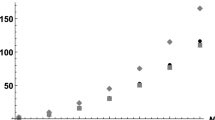Abstract
For quantum systems, we expect to see the classical behaviour at the limit of large quantum numbers. Hence, we apply Bohmian approach for describing the evolution of Earth around the Sun. We obtain possible trajectories of the Earth system with different initial conditions which converge to a certain stable orbit, known as the Kepler orbit, after a given time. The trajectories are resulted from the guiding equation \(p=\nabla S\) in the Bohmian mechanics, which relates the momentum of the system to the phase part of the wave function. Except at some special situations, Bohmian trajectories are not Newtonian in character. We show that the classic behaviour of the Earth can be interpreted as the consequence of the guiding equation at the limit of large quantum numbers.





Similar content being viewed by others
References
D Keeports, Eur. J. Phys. 33, 1587 (2012)
D Dürr, S Goldstein and N Zanghi, J. Stat. Phys. 67, 843 (1992)
P Holland, The quantum theory of motion: An account of the de Broglie–Bohm casual interpretation of quantum mechanics (Cambridge University Press, Cambridge, 1995)
F Rahmani, M Golshani and M Sarbishei, Pramana – J. Phys. 86(4), 747 (2016)
F Rahmani, M Golshani and M Sarbishei, Pramana – J. Phys. 87(2): 23 (2016)
J Y Koupaei and M Golshani, J. Math. Phys. 54(12), 122107 (2013)
A Tilbi, T Boudjedaa and M Merad, Pramana – J. Phys. 87(5): 66 (2016)
D Dürr and S Teufel, Bohmian mechanics: The physics and mathematics of quantum theory (Springer, Berlin, Heidelberg, 2009)
E Flöthmann and K H Welge, Phys. Rev. A 54, 1884 (1996)
M C Gutzwiller, Chaos in classical and quantum mechanics (Springer, Berlin, Heidelberg, 1990)
J Laskar, P Robutel, F Joutel, M Gastineau, A C M Correia and B Levrard, Astron. Astrophys. 428, 261 (2004)
E Battista and G Esposito, Phys. Rev. D 89, 084030 (2014)
M C Gutzwiller, Rev. Mod. Phys. 70, 589 (1998)
M J Holman and N W Murray, Astron. J. 112, 1278 (1996)
H A Bethe and E E Salpeter, Quantum mechanics of one- and two-electron atoms (Springer Verlag, Berlin, New York, 1957)
E Nielsen, D V Federov, A S Jensen and E Garrido, Phys. Rep. 347, 373 (2001)
J Carlson and R Schiavilla, Rev. Mod. Phys. 70 743 (1998)
G Tanner, K Richter and J M Rost, Rev. Mod. Phys. 72, 497 (2000)
A S Jensen, A Cobis, D V Fedorov, E Garrido and E Nielsen, Few-Body Syst. 10, (Suppl.) 19 (1999)
B Jonson and K Riisager, Philos. Trans. R. Soc. Lond. A 356, 2063 (1998)
J M Randazzo, F Buezas, A L Frapiccini, F D Colavecchia and G Gasaneo, Phys. Rev. A 84, 052715 (2011)
F Robicheaux, Phys. Rev. A 60, 1706 (1999)
G Chen, Z Ding, A Perronnet and Z Zhang, J. Math. Phys. 49, 062102 (2008)
A Yahalom, J Levitan, M Lewkowicz and L Horwitz, Phys. Lett. A 375, 2111 (2011)
X Cui, Few-Body Syst. 52, 65 (2012)
R Castelli, Commun. Nonlinear Sci. 17, 804 (2012)
H W Hamber and S Liu, Phys. Lett. B 357, 51 (1995)
S Naoz, B Kocsis, A Loeb and N Yunes, Astrophys. J. 773(2), 187 (2013)
J Hartung and J Steinhoff, Ann. Phys. 523, 783 (2011)
T Damour, P Jaranowski and G Schäfer, Phys. Rev. D 62, 021501 (2000)
J S Townsend, A modern approach to quantum mechanics (University Science Books, CA, USA, 2000)
D Bohm, Phys. Rev. 85, 166 (1952)
D Bohm and B J Hiley, The undivided universe: An ontological interpretation of quantum theory (Routledge, UK, 2006)
Acknowledgements
The authors would like to thank M Koorepaz Mahmoodabadi for his assistance and useful comments on the nonlinear equations with closed cycles which improved their ideas on the subject.
Author information
Authors and Affiliations
Corresponding author
Appendix A
Appendix A
The differential equation (18) can be solved in any time domain in which \(\xi \) is considered as a constant. One can write this equation as
where both \(\theta \) and r are time-dependent, but have no dependency on each other. For \(\theta \) we have from (9)
During the Earth’s rotation around the Sun, the time variations of r are insignificant. With regard to (A.2) and noticing that the constant \(Z_h\) has the same order of magnitude as r, one can neglect the time dependency of \(\theta \) too. Therefore, to solve eq. (A.1), we can consider the term \(\xi \sin \theta \) as a constant.
Define the variable q as
where \(r_\mathrm{eq}\) represents the equilibrium distance, and eq. (A.1) yields
Hence, the variable q represents the deviation of r from the equilibrium distance \(r_\mathrm{eq}\simeq a\). The term \(q/r_\mathrm{eq}\) is small, so that one can expand \((1+q/r_\mathrm{eq})^{-1}\) to obtain
By expanding the radical term, one finally gets
where B is already defined in eq. (22). Equation (A.6) is a linear differential equation which can be solved easily. Consequently, eq. (20) is obtained as an answer from (A.6), followed by relations (21) and (22) as definitions in (20).
Rights and permissions
About this article
Cite this article
Soltanmanesh, A., Shafiee, A. Determination of classical behaviour of the Earth for large quantum numbers using quantum guiding equation. Pramana - J Phys 93, 52 (2019). https://doi.org/10.1007/s12043-019-1820-5
Received:
Revised:
Accepted:
Published:
DOI: https://doi.org/10.1007/s12043-019-1820-5




